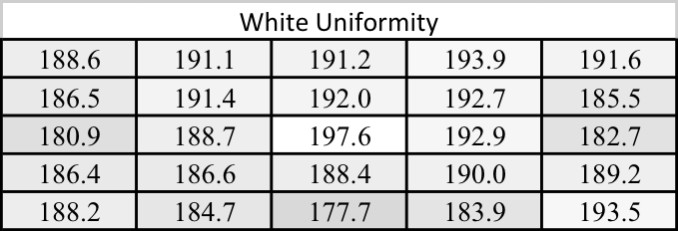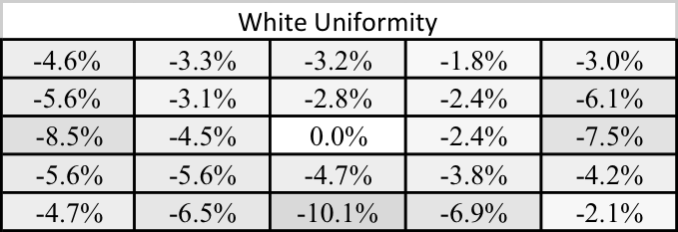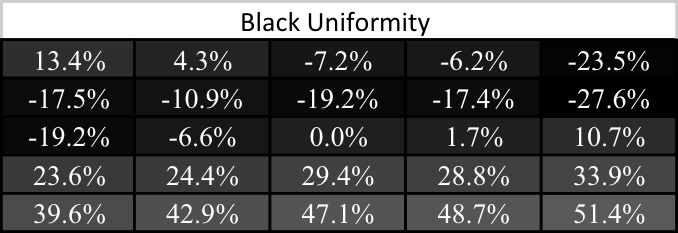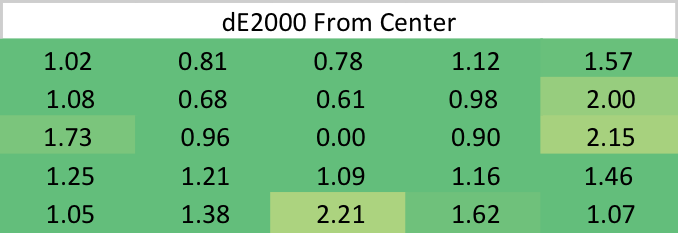The 9.7" iPad Pro Review
by Brandon Chester on June 1, 2016 9:00 AM ESTDisplay Uniformity
With Apple billing the 9.7" iPad Pro as a professional device with individually calibrated displays, I felt it was relevant to bring our uniformity test over to mobile. While we usually just measure errors at the center of a display, there are also errors across the panel itself due to inconsistencies in the panel and the backlighting array. This means that a display can be accurate at the center, but the edges can have significant luminance dropoff or gain that makes the display unsuitable for any sort of image work due to the fact that there are visible color differences across the display itself. For this test we use an array of 25 points on the display and measure the accuracy of colors in the GretagMacbeth ColorChecker test, as well as the uniformity of the white and black levels at each spot.
While I don't have any other mobile devices for reference, if I were evaluating the 9.7" iPad Pro as a professional monitor I would say that the white uniformity is decent, but not amazing in any regard. The central area of the display is fairly uniform, but there's noticeable dropoff on the left, right, and bottom edges. This is something I see on a number of phones and tablets, and maintaining uniformity probably hasn't been a concern for vendors until this point, but I'm hoping that a larger focus on it will make companies put more focus on it as a selling point for professional devices.
Black uniformity on the 9.7" iPad Pro isn't great. If you divide the display along its diagonal from the top right to bottom left corners you see that the in general the bottom section has higher black levels, while the top has lower black levels. In general, the black level isn't as dark at the edges as it is in the center. Black levels and contrast are the areas where Apple's LCDs really can't compete with Samsung's AMOLEDs, and with the 9.7" iPad Pro falling pretty far behind its bigger brother with black levels Apple should put more focus on at least keeping their blacks consistent across the display.
While the black uniformity isn't great on the 9.7" iPad Pro, and the white uniformity is just okay, the uniformity for colors is outstanding. There are a few hot spots on the edges, but in general the error relative to the center is well under two, and often near or even below one. I'm surprised that Apple has such uniform color rendition, as an uneven luminance level will usually throw off colors much more severely. Whatever the case may be, you can at least depend on even color rendering across the 9.7" iPad Pro's display.















144 Comments
View All Comments
UtilityMax - Friday, June 3, 2016 - link
The thick and bulky Surface Pro 4 is hardly a tablet..damianrobertjones - Tuesday, June 14, 2016 - link
I have no issues using it as a tablet and I also own an ipad mini 4.ragingfighter - Wednesday, July 13, 2016 - link
I think the surface pro line depending on how one uses it makes it a competitive choice as opposed to a new Apple tablet. Many people go for the higher-end storage of the surface tablet and that regard it's price is ridiculous when you start talking $1500 for a tablet to me at the feats the purpose for $1500 you can get yourself an amazing laptop. Still would have more memory at least by double maybe even triple and the specs will be as well if you opt for mid tier say 128 GB storage solution if you have an external hard drive plugged in because it has USB three you can save yourself a lot of money. In that regard it's a small use of what the surface provides as an option and also it's an idea of saving money that makes it viable choice. Obviously the recovery partition and the operating system take up a lot of space in comparison to something like iOS or even the android platform built in storage does take a bit of a beating because of it but if you can use everything on a portable hard drive that's plugged in the USB three and run the surface and such in the way it will make the base cost far less and much more approachable. I just think in general tablets beyond I would say $800 becomes problematic specifically because you get into an upper mid tier of what a laptop can offer you for $800 and beyond and you get a lot still you can still have a decently portable laptop with a decent amount of power. Laptops though in this price range and below take a hit in quality and the most important aspect and that is the screen usually this price point or below have very crappy screens the color and their sharpness and infidelity are really not phenomenally up there. When you get in the laptops beyond $1000 point you start getting sharper queen or technology implemented into them. I feel it is important when it comes to a comparison of options out to complete a task. It comes down to really what is cost-effective for your workflow how much you need portability and how much of a solution a tablet aspiring to be a laptop killer a replacement can become Closest tablet to achieve such your feat is the Microsoft surface.ragingfighter - Wednesday, July 13, 2016 - link
Though I am a Mac user I must admit that in regards to any kind of a portable keyboard Apple they dropped the ball when I came to the iPad keyboard. It is a step behind Microsoft smart cover keyboard one because it's not backlit but also because of the way out the bun travel is smaller and the buttons are smaller not necessarily a favorite for everybody. The biggest design thing that I think Apple completely messed and I have to give kudos to Microsoft is the built in stand. I'm not a super fan of windows though I know how to use Windows and use a Windows it is nowhere near my primary platform which is the Mac. But I have to give credit to Microsoft where credit is due the surface pro line is and where the tablet but even I have to met there are many different kiosks I have been to where the tablet has malfunctioned during time of demoing it is much more rare to see an iPad completely not work for kiosk purposes that it is for surface tablet I've seen their tablets not even turn on even with the power cord extend it to them plugged in fully lights show it is fully charged but outside of doing a direct comparison to the different pros and cons of each wall smart enough to know what fits our needs the best for me and iPad is a good tablet and it doesn't basically what I needed to and for others the Microsoft surface pro line suits their needs as well. Trust me we want to open a can of apples and Microsoft comparisons here. Just say they're equally respectable types of tablets based on their own individual merits the only reason I bring up the prior points in general are because a tablet should have a stand and not needing a case to provide such or solution is a very added and welcome bonus the people on a surface tablet. Myself I don't want to surface tablet but I will give them credit for that additionMeteor2 - Thursday, June 2, 2016 - link
I'd like to see the Pro 4 in the charts where possible, please. They are aiming at similar users. I'd love to see the Dell 7275 tested though, as it looks (and feels, after using one for an hour) in many ways better than the MS Pro.blackcrayon - Monday, June 6, 2016 - link
Why would you think a 9.7" iPad Pro is aiming at similar users as a Surface Pro 4?damianrobertjones - Tuesday, June 14, 2016 - link
The word 'pro' is being used. Blame Apple.Tikcus9666 - Saturday, June 4, 2016 - link
In the UK the ipad pro 9.7" with 128GB is priced only £100 less (or a few £, if you opt for cellular version) than the Surface Pro 4 entry level with m3, 4GB and 128GB.I think comparison is very valid, also for a "Pro" device, to be considered as a "Pro" device we need more than web benchmarks, and battery life..... until it runs photoshop, lightroom, muse, sony vegas to name a few, it aint replacing a PC for real Pro's
tipoo - Wednesday, June 1, 2016 - link
I've been curious - it has less memory bandwidth than the 12.9", but not halved, despite half the pinout width and half the DRAM capacity. Does the chip reintroduce the L3 cache? That could explain it.Ryan Smith - Wednesday, June 1, 2016 - link
No. It has half the memory bandwidth. CPU benchmarks just don't show the full effect.